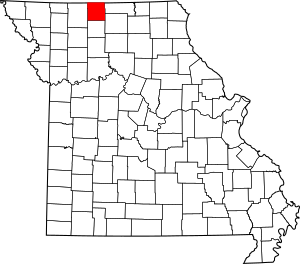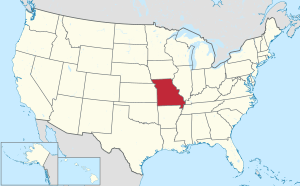Mercer County, Missouri facts for kids
Quick facts for kids
Mercer County
|
|
|---|---|

Location within the U.S. state of Missouri
|
|
 Missouri's location within the U.S. |
|
| Country | |
| State | |
| Founded | February 14, 1845 |
| Named for | John Francis Mercer |
| Seat | Princeton |
| Largest city | Princeton |
| Area | |
| • Total | 455 sq mi (1,180 km2) |
| • Land | 454 sq mi (1,180 km2) |
| • Water | 1.3 sq mi (3 km2) 0.3% |
| Population
(2020)
|
|
| • Total | 3,538 |
| • Density | 7.776/sq mi (3.002/km2) |
| Time zone | UTC−6 (Central) |
| • Summer (DST) | UTC−5 (CDT) |
| Congressional district | 6th |
Mercer County is a county located in the northwestern part of Missouri, a state in the United States. In 2020, about 3,538 people lived there, making it one of the less populated counties in Missouri. The main town and county seat is Princeton. Mercer County was officially created on February 14, 1845. It was named after General John F. Mercer, a hero from the American Revolutionary War.
History
How Mercer County Began
Mercer County was formed on February 14, 1845. It was originally part of Grundy County. The county is named after General Hugh Mercer, who was a brave soldier in the American Revolutionary War and sadly died in battle.
The first people to settle permanently in what is now Mercer County arrived in 1837. These were families from other parts of Missouri. James Parsons, from Tennessee, is thought to be the very first permanent settler in the spring of 1837. At that time, this land was part of Livingston County. Later, in 1841, it became part of the new Grundy County.
Before 1837, the land was mainly used by Native American tribes, especially the Sac/Fox and Potawatomi. They used it as excellent hunting grounds. Sometimes, these tribes would set up temporary hunting camps, but otherwise, the land was empty of people.
The town of Princeton was chosen as the county seat in 1847. It was named after the Battle of Princeton, where General Mercer was killed. For the first six years of the county's existence, its northern border was unclear because of the Honey War. This was a disagreement over land between Missouri and Iowa, but thankfully, no one was hurt. Before 1851, the border was about 9.5 miles farther north than it is today, until the U.S. Supreme Court made a decision.
Mercer County During the Civil War
Mercer County, like its neighbor Putnam County, strongly supported the Union during the American Civil War. Most residents had come from northern states like Pennsylvania, Ohio, and Indiana. They did not have the tradition of owning enslaved people, which was common in some other northern Missouri counties.
In 1860, only 12 families in Mercer County owned enslaved people, with a total of 24 enslaved individuals. Fewer than 20 men from Mercer County fought for the Confederacy. However, more than 1,000 men from the county volunteered to serve the Union.
Soldiers from Mercer County joined units like the 23rd, 27th, and 35th Regiments, the 2nd and 12th Cavalry, and the 5th Kansas Cavalry. The 44th Missouri Infantry (USA), which included men from Mercer, Grundy, and Sullivan counties, played a key role in the Union victory at the Battle of Franklin, Tennessee, in November 1864.
Geography
Mercer County covers a total area of 455 square miles. Most of this (454 square miles) is land, and only a small part (1.3 square miles, or 0.3%) is water.
Neighboring Counties
Mercer County shares borders with these other counties:
- Decatur County, Iowa (to the northwest)
- Wayne County, Iowa (to the north)
- Putnam County (to the east)
- Sullivan County (to the southeast)
- Grundy County (to the south)
- Harrison County (to the west)
Main Roads
Population Facts
| Historical population | |||
|---|---|---|---|
| Census | Pop. | %± | |
| 1850 | 2,691 | — | |
| 1860 | 9,300 | 245.6% | |
| 1870 | 11,557 | 24.3% | |
| 1880 | 14,673 | 27.0% | |
| 1890 | 14,581 | −0.6% | |
| 1900 | 14,706 | 0.9% | |
| 1910 | 12,335 | −16.1% | |
| 1920 | 11,281 | −8.5% | |
| 1930 | 9,350 | −17.1% | |
| 1940 | 8,766 | −6.2% | |
| 1950 | 7,235 | −17.5% | |
| 1960 | 5,750 | −20.5% | |
| 1970 | 4,910 | −14.6% | |
| 1980 | 4,685 | −4.6% | |
| 1990 | 3,723 | −20.5% | |
| 2000 | 3,757 | 0.9% | |
| 2010 | 3,785 | 0.7% | |
| 2020 | 3,538 | −6.5% | |
| U.S. Decennial Census 1790-1960 1900-1990 1990-2000 2010-2015 |
|||
In 2010, there were 3,785 people living in Mercer County. The population density was about 8 people per square mile. Most residents (98.72%) were White. About 23% of the population was under 18 years old. The median age was 42 years.
2020 Census Information
| Race | Num. | Perc. |
|---|---|---|
| White (not Hispanic) | 3,291 | 93% |
| Black or African American (not Hispanic) | 0 | 0% |
| Native American (not Hispanic) | 8 | 0.23% |
| Asian (not Hispanic) | 0 | 0% |
| Pacific Islander (not Hispanic) | 0 | 0% |
| Other/Mixed (not Hispanic) | 84 | 2.37% |
| Hispanic or Latino | 155 | 4.4% |
Religion in Mercer County
Religion in Mercer County, according to ARDA (2020) Evangelicals Churches (62.5%) Anabaptist Churches (Amish and Mennonite) (9.1%) Mainline Protestant Churches (6.2%) None (19.6%)
Education
Mercer County has two main school districts:
- North Mercer County R-III School District - located in Mercer
- North Mercer County Elementary School (Grades PK-6)
- Mercer High School (Grades 7-12)
- Princeton R-V School District - located in Princeton
- Princeton Elementary School (Grades PK-6)
- Princeton High School (Grades 7-12)
Public Libraries
- Mercer County Library
Communities
Cities
- Mercer
- Princeton (This is the county seat, meaning it's the main town where the county government is located.)
Village
Census-Designated Place
- Ravanna (A census-designated place is a community that looks like a town but isn't officially incorporated as one.)
Other Communities
Historical Communities
These are places that used to be communities in Mercer County:
- Adel
- Alvord
- Burrows
- Cleopatra
- Dinsmore
- Goshen
- Half Rock
- Ilia
- Saline
- Topsy (Newtown)
- Wataga
Townships
A township is a smaller division of land within a county. Mercer County has these townships:
- Harrison
- Lindley
- Madison
- Marion
- Medicine
- Morgan
- Ravanna
- Somerset
- Washington
See also
 In Spanish: Condado de Mercer (Misuri) para niños
In Spanish: Condado de Mercer (Misuri) para niños

